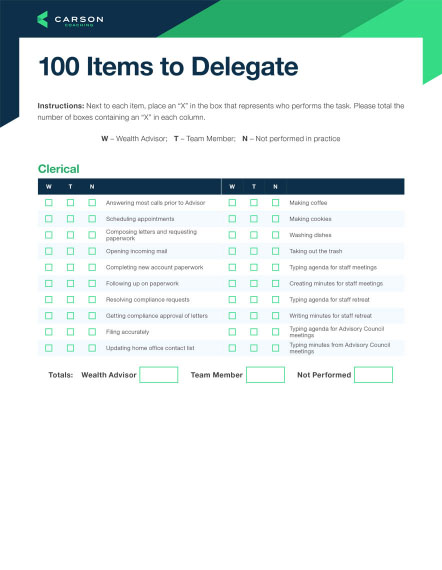Most of us have heard the expression “Working on the business as opposed to in the business.”
This reflects the idea that effective business leaders regularly carve out time to think about how well their business is running, where it can be improved and the degree to which its current trajectory aligns with the long-term vision.
To my mind, this is the perfect encapsulation of the shift in mindset from advisor to CEO. Advisors are often in the weeds, concentrating on the technical details of financial planning, investment strategies and how those elements align with their clients’ ever-evolving financial circumstances. Depending on the size and nature of the clientele and the team structure that has been built, these activities alone can be all-consuming.
Generally, as time passes and the firm grows, specialization rises. Lead advisors are increasingly able to delegate clients and leadership responsibilities to team members they trust who have the capability, capacity and desire to do that work. These are the foundational steps in embracing the CEO mindset.
Extricating yourself from the day-to-day allows you to spend more time on your unique skills and the activities that only you can perform. Redirecting your time to high-value activities can result in better financial performance, enhanced firm value, greater organizational efficiency and the consistent execution of key business functions.
Stated bluntly, client service is a critical firm function, but it’s not at all important that you’re the one who delivers it. If you’ve developed a team that delivers on your approach to the client experience and administers a client engagement model that inspires referrals, client retention is achievable without your direct involvement. These are not fanciful notions from a wild-eyed theorist! I see this often in my role as Executive Business Coach.
A quick Google search will return many articles that describe how the executives of the largest companies with tens of thousands of employees stay productive and on target. They focus exclusively on those activities that only they can accomplish. In other words, anything that can be delegated, is delegated. I believe this is a smart approach for leaders of smaller firms, as well.
In this blog post, I’ll offer you step-by-step guidance on how to make the transition from advisor to CEO and give you the elements of a scalable foundation, which is essential to scale your firm efficiently as a CEO.
The Transition Step-by-Step
Moving from the conceptual to the practical, below is a high-level, step-by-step action plan to make the transition from advisor to CEO. I strongly encourage you to work with a Carson Executive Business Coach to convert these ideas into reality:
- Develop a sustainable, extensible client service model that creates alignment in two key areas: (1) The expenditure of firm resources, both money and time, with the value received from clients, both fees and introductions to top prospects; and (2) the expertise, experience and gravitas of the advisor with the complexity of the clients’ financial circumstances.
- Attract and retain a team that consistently executes that service model.
- Identify those activities you love and at which you are insanely great, and delegate everything else.
- Determine success measurements and an associated review methodology that enables you to periodically assess forward momentum in the areas that are most important to you. (See my blog on how key performance indicators can give you more control over your revenue, profitability and resources and for great ideas on KPI management.)
- Develop and implement continuation and succession plans. (There are two ways to exit your business – planned and unplanned; these plans account for both.)
- Direct your energies to three key areas: (1) replicating the top clients your firm most enjoys working with; (2) growing long-term enterprise value by focusing on valuation drivers on which your firm scores poorly; and (3) developing and consistently implementing the scalable foundation described in the next section.
Scalable Foundation: The CEO’s Pathway
I believe that before a firm can scale consistently and effectively, it must have a scalable foundation in place. The foundation includes the following elements:
- A strategic vision that guides you through the vast array of possibilities to the course that’s absolutely right for you, your team and your clients. Your documented vision answers the question: What kind of firm do you want to be?
- A staffing model that allows you to grow the way you want to, deliver exceptional client service, control the amount of time you spend at the office and allow the lead advisor(s) to maintain a laser focus on high-value activities. Those high-value activities could be nurturing top-tier relationships, soliciting new top-tier relationships and developing and executing your strategic vision.
- A service model that ensures a consistent set of deliverables and client interactions that are differentiated by segment: a client engagement model that inspires referrals.
- A process orientation – a detailed, documented series of workflows that results in an organized, systematized and – wherever appropriate – automated implementation of your key business functions.
- A model-driven investment management approach and a modular planning methodology that allows for an appropriate level of customization, but that can be consistently and quickly employed and maintained.
As we’re wrapping up, I want to share this important observation. I’ve described an approach that suggests moving beyond client service. Doing so allows you to prioritize aspects of the business that have the most impact on the bottom line and may best align with your skills and preferences.
This is an ideal solution for many firm leaders, but not all. Some firm CEOs continue to serve a number of top clients because they want to keep their finger on the pulse of relationship management and they enjoy the social connection with a few select clients they have known a long time.
So, adopting the CEO mindset doesn’t need to be black or white. Choose your own shade of gray – or silver, slate, gunmetal or platinum.
Engage your coach to help you set your sights, and then create and follow up on an action plan to bring your best ideas to life. Your most joyful, productive and fulfilling work experiences lie at the end of this path.


